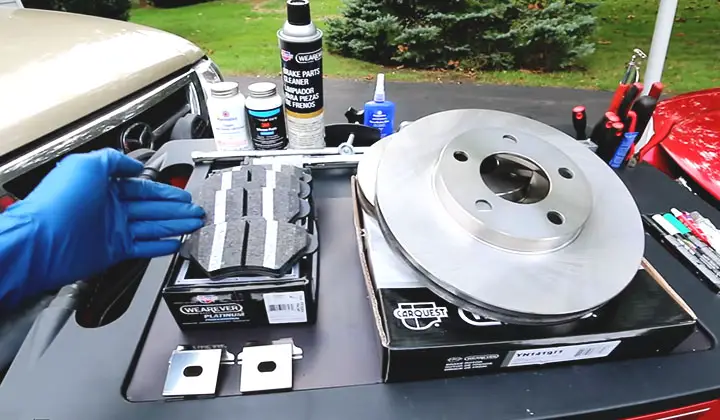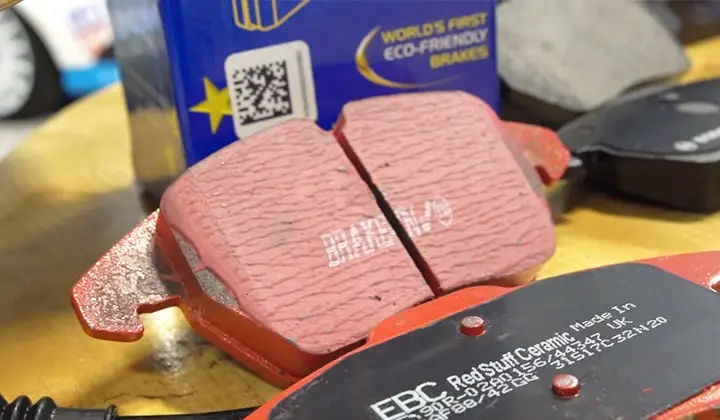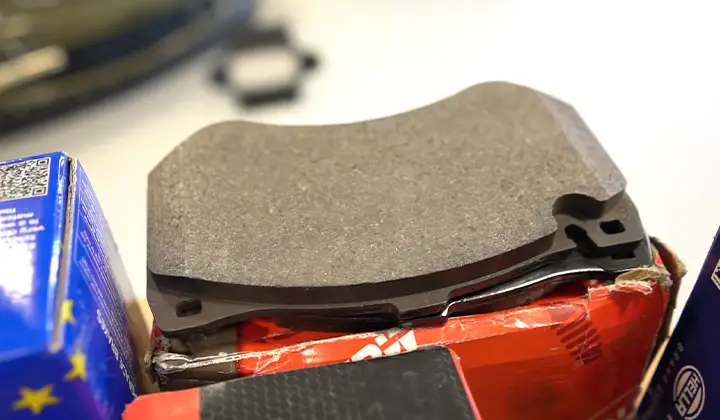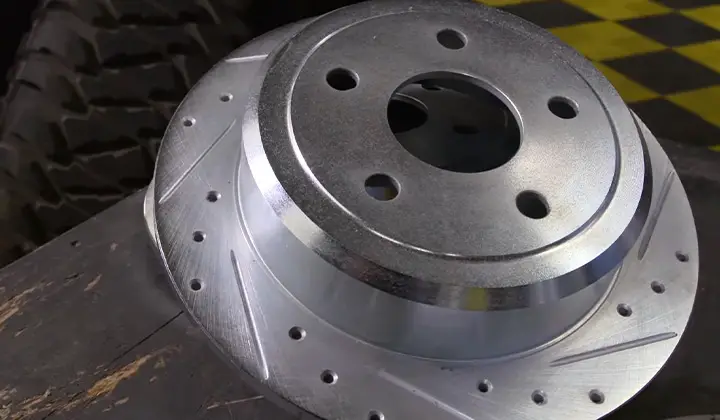Brake pads made from ceramic can wear out rotors faster than those made from other materials. When your brake pads start to fail, you’ll need to replace them as soon as possible to avoid a dangerous situation on the road.
Ceramic brakes are more expensive than other types of brakes, but they’re worth it in the long run if you want safe driving habits.
Make sure you have regular inspections and replacements done on your car’s braking system so that degradation doesn’t happen over time.
Be aware of how often your brake pads should be replaced by checking your vehicle’s owner’s manual or online resources.
Contents
- 1 Do Ceramic Brake Pads Wear Out Rotors Faster
- 2 Brake Pads and Rotors
- 3 Advantages of Ceramic Brake Pads:
- 4 Disadvantages of Ceramic Brake Pads:
- 5 FAQs
- 5.1 Are Ceramic Brake Pads Bad for Rotors?
- 5.2 Do Ceramic Brakes Need Special Rotors?
- 5.3 How Long Do Ceramic Brake Rotors Last?
- 5.4 Are Ceramic Brakes Worth the Money?
- 5.5 How Long Will Ceramic Brake Pads Last?
- 5.6 Do Ceramic Brakes Feel Different?
- 5.7 Do Ceramic Brake Pads Squeak?
- 5.8 Do Ceramic Brakes Wear Out?
- 5.9 How Long Does It Take for New Brake Pads to Settle?
- 5.10 How Many Times Do You Need to Pump the Brakes After a Pad Change?
- 5.11 Do Black Rotors Fade
- 6 Conclusion
Do Ceramic Brake Pads Wear Out Rotors Faster
Ceramic brake pads can wear out rotors faster than regular brake pads, especially if the car is driven aggressively or in stop-and-go traffic. Over time, this can cause the rotor to become warped and less effective at stopping the car.
Brake Pad Wear and Rotor Behavior
Ceramic brake pads are designed to last for a certain amount of time before they need to be replaced. However, over time, the brake pad will start to wear down and this will cause a change in rotor behavior.
This can lead to increased stopping distances as well as decreased braking performance overall.
Increased Noise Levels
When the brakes start coming up against harder objects or surfaces, they may start producing more noise due to friction between the pad and rotor material. Over time, this noise may become louder and more noticeable.
Poor Stopping Distance Performance
If your car’s brakes are wearing down faster than expected, it might experience reduced stopping distance performance when compared with when its brakes were new or in their prime condition.
Loss of Braking Power When needed Most
Losing braking power is never fun but it can happen if your car’s brake pads are starting to wear down too quickly – causing them to no longer have enough grip on the rotors for effective braking during emergency situations.
Brake Pads and Rotors
There are many types of brake pads, each with its own benefits and drawbacks. It’s important to choose the right type for your car and your driving style.

There are many types of brake pads, and each has its own specific purpose. Some pads stop the car by friction against the rotors, while others use a chemical reaction to do so. Here are some of the most common types:
Ceramic Brake Pads
Ceramic brake pads are the most common type of brake pad and are made from a mixture of ceramic and rubber. They have good stopping power but tend to wear down quickly.

Metallic Brake Pads
Metallic brake pads are made from a combination of metal and plastic and have good braking power but can be difficult to install because they require special tools.
Semi-Metallic Brake Pads
Semi-metallic brake pads use a blend of metals that helps them to provide excellent braking performance while being easier to install than metallic brakes.

They may not last as long as other types of brakes, but they offer an affordable option for those who want quality performance without spending too much money on repairs later on down the road.
Piston
These pads use a piston to push against the wheel, providing maximum braking power. They’re good for cars that don’t have discs or rotors because they require less maintenance than other types of brakes.
However, pistons can be noisy when stopping on hard surfaces.
Disc
Discs stop vehicles by pushing caliper seals against the disc surface. This causes friction which stops the vehicle quickly.
Discs are more expensive than pistons but last longer and provide better-stopping performance in wet conditions.
Rotors
Rotors use magnets to slow down the car and prevent it from spinning out of control during a crash. They’re usually paired with either discs or pistons, depending on how much force you need to stop quickly

The friction of Different Brake Pads
There are three main types of brake pads – friction, wear, and noise. Friction brakes use metal plates that rub together to stop the car. Wear pads use a compound to resist wear and tear from braking so they last longer.
Noise pads make less noise than other brands but can fade quickly in hot weather or when subjected to high levels of vibration.
How do they work
Brake pad materials come in two varieties – solid or liquid-based. Solid-state discs rely on small iron particles embedded within the polymer matrix which create friction when used in conjunction with hydraulic pressure (to stop the car).
Liquid-state discs rely on an oil/water mixture that creates resistance by becoming thicker as it cools down after being activated by heat (to stop the car).
Better Brake Pads for my vehicle
It depends on your specific needs. Some vehicles require more aggressive braking performance while others may be fine with standard brake pads provided, they’re replaced regularly enough to avoid rusting out prematurely.
Advantages of Ceramic Brake Pads:
Ceramic brake pads can wear out rotors faster than traditional brake pads. This is because they are designed to dissipate heat more quickly. When the rotor starts to become worn, it may start to bind up with the pad material and cause a braking problem.
Quieter Braking
Ceramic brake pads can make your car sound quieter when braking, which may lead to you thinking that your brakes are working better than they actually are.
This reduction in noise is a result of the ceramic material dissipating heat more efficiently and lessening the amount of dust created during braking.
Lower Brake Dust
When ceramic brake pads hit the ground, they create far less dust than traditional brake pads. This means that you won’t have to regularly clean your rotors or change your pad wear indicator (PWI) fluid as often.
Long Lasting
The life span of a ceramic brake pad is typically longer than that of a standard metal or plastic pad, meaning that it will need to be replaced less frequently over time.
Ceramic brakes also require little maintenance once installed, making them an ideal choice for those who value convenience and peace of mind above all else.
Decent Heat Reduction
Ceramic brake pads are known for their ability to dissipate heat quickly and resist the range of temperatures that a typical rotor can withstand.
This means that your brakes will work better in extreme weather conditions, including cold winter weather and hot summer days.
Withstands Range of Temperatures
Ceramic brake pads are much more resistant to salt and water than traditional rotors, which makes them ideal for use on vehicles that live in harsh climates or travel across varied terrains.
Better Resistant to Salt and Water
Ceramic brake pads also tend to hold up better under harsh climatic conditions due to their resistance to salt and water deposits
Disadvantages of Ceramic Brake Pads:
Ceramic brake pads are a newer type of brake pad that many car owners have switched to. They are supposed to offer better braking performance than traditional pads, but some experts believe they may wear rotors faster.
If you’re worried about this possibility, it’s best to get your brakes checked regularly by a mechanic.
More Expensive
Ceramic brake pads are more expensive than traditional brake pads, and they may not be suitable for extreme cold climates or for applications that require severe duty.
Not Suitable for Extremely Cold Climates
Ceramic brake pads are not recommended for use in extremely cold climates because the heat from the brakes will cause them to wear out faster than other types of brakes.
Not Recommended for Severe-duty Applications
Using ceramic brake pads on a vehicle that is used in severe-duty applications can result in excessive rotor wear, which can eventually lead to failure.
Create Excessive Rotor Wear
Ceramic brake pads may wear out your rotors faster than traditional brake pads because they don’t generate heat like metal or plastic brakes do.
This can cause the rotors to become uneven and prone to breaking, which can lead to decreased braking performance and increased risk of accidents.
FAQs
Are Ceramic Brake Pads Bad for Rotors?
No, ceramic brake pads are a popular choice for drivers and bike riders because they offer better stopping power than their metal counterparts.
Do Ceramic Brakes Need Special Rotors?
The answer is yes, ceramic brakes need special rotors. The rotor should be made from a ceramic material and have an even thickness.
How Long Do Ceramic Brake Rotors Last?
The lifespan of ceramic brake rotors depends on the type of application it is being used for.
For example, braking in an industrial setting can last up to 10 years while a car that is used more frequently will have a shorter lifespan.
Are Ceramic Brakes Worth the Money?
Ceramic brakes are becoming more and more popular in the market. They are both durable and efficient. However, ceramic brakes don’t come cheap.
How Long Will Ceramic Brake Pads Last?
They last longer than other brake pads and can be used for up to 6 years without needing replacement.
Do Ceramic Brakes Feel Different?
Yes, they do, but not in the way you might think. The material is harder and grippier than metal, and it’s also lighter. This makes them easier to control at high speeds.
Do Ceramic Brake Pads Squeak?
Yes, ceramic brake pads do squeak. This can be a nuisance for drivers but it’s not something that needs to be replaced or repaired.
Do Ceramic Brakes Wear Out?
It depends on how often you use your bike. If you use your bike for commuting or exercise, you will likely see less wear on your pad.
How Long Does It Take for New Brake Pads to Settle?
The length of time it takes for new brake pads to settle varies from brand to brand and model to model. Some brands have settled after a few minutes while others may take hours or even days.
How Many Times Do You Need to Pump the Brakes After a Pad Change?
After every pad change, you should pump the brakes three times. This is because the brake fluid gets dirty and needs to be flushed out of the system with each pump.
Do Black Rotors Fade
Black rotors fade over time and they become more difficult to see as they age.
Conclusion
Brake pads are an essential part of any car, and ceramic brake pads are no exception.
However, over time they can wear out your rotors faster than traditional brake pads – so it’s important to replace them on a regular basis.
If you don’t regularly change your brake pad, you could end up having to replace your entire rotor assembly.
To make sure you get the best performance from your brakes, always have a set of replacement pads on hand – and keep an eye on the condition of your rotors too.
